TMMC: Reference Adsorption Isotherms for CH4 in Metal-organic Frameworks
Grand-canonical Transition-Matrix Monte Carlo (GC-TMMC) simulations [1, 5-10] of CH4 were performed at T = 300 K and 350 K in four metal-organic frameworks (MOFs). The particle number range was divided into windows advanced trial moves were performed to ensure adequate sampling at high densities. The main result of a GC-TMMC simulation is the particle number probability distribution (PNPD), which is constructed by stitching together the particle number distributions from each window. The adsorption isotherm may be determined from the PNPD [10]. At each value of N, average total potential energies U were collected and these quantities were used to compute the isosteric heat of adsorption.
Simulations used a standard, conventional set of unbiased Monte Carlo moves, as described below. Since the simulations were run at a high temperature for the model fluid, all windows used conventional TMMC mode without Wang-Landau initialization.
All simulations were performed using the open-source FEASST Monte Carlo engine [13], version v0.21.1 (commit hash fad5d0d6575a2ed8251d7093e1a250d634cbbcb4).
Other key simulation details common to all simulations are given below:
| Fluid Model | TraPPE CH4[11] | |
| Lennard-Jones cutoff | 12A, with linear-force shift tail | |
| Ewald Parameters | Set according to DL_POLY recipe [14], with relative tolerance 10-5 | |
|
Standard Move Set |
Translation, weight 0.3 |
|
| Total MC Trials | 1.0e8 for ZIF-8, CuBTC, and IRMOF-1; 5.0e8 for UiO-66 | |
| Bias update freq | 1.0e6 | |
| Physical Parameters | CODATA 2018 [12] | |
The adsorbent MOFs were reconstructed from publicly-available crystal structures and replicated to ensure that the simulation cell was at least twice the cutoff radius in all dimensions. Forcefields for each MOF were taken from published literature. The MOF structure and forcefield are provided in FEASST particle files in the data repository associated with this page (see "Data Availability" below). Coulombic interactions were ignored since the TraPPE CH4 particle has no charge [2,3]. Lorentz-Berthelot mixing rules were used to set the unlike-atom Lennard-Jones parameters.
Simulation details specific to each MOF
| ZIF-8 | CuBTC | UiO-66 | IRMOF-1 | |
| Number of Windows | 60 | 40 | 80 | 40 |
| Nmax | 300 | 210 | 480 | 235 |
| Unit Cell Replication (Nx, Ny, Nz) | (2,2,2) | (1,1,1) | (2,2,2) | (1,1,1) |
| Cubic Box Dimensions (A) | 34.023240 | 26.3430 | 41.40080 | 25.6690 |
| Simulation MOF Mass (amu) | 21846.91 | 9677.91 | 53249.82 | 6158.94 |
| MOF Forcefield, Reference |
Snurr [15] | Calero IV [16] | Snurr [17] | DREIDING [18] + m-CBAC [19] |
| FEASST MOF Particle | data.ZIF8_Snurr_rep222 | data.CuBTC_CaleroIV_rep111 | data.UiO66_Snurr_rep222 | data.IRMOF1_mCBAC_rep111 |
Note: all four MOFs have cubic unit cells
The result of each simulation is the PNPD and average potential energy (for each N state). The PNPD may be used to compute the adsorption isotherm by the histogram-reweighting procedure described by Siderius and Shen [10]. All systems were single phase and, hence, no phase decomposition of the PNPD was necessary. The pressure for a particular chemical potential was determined from GC-TMMC simulation of the bulk CH4 fluid [4]; the PNPD and average potential energy of the bulk fluid are also provided in the associated data repository. Note that the TraPPE CH4 fluid is just a Lennard-Jones fluid; the cutoff selected here corresponds to a Lennard-Jones fluid with cutoff of 3.217σ.
The isosteric heat of adsorption was computed as
$$ q_{st} = k_B T -\dfrac{<UN>-<U><N>}{<N^2> - <N>^2}$$
The <...> brackets indicate grand-canonical averages
Results
Temperature = 300K
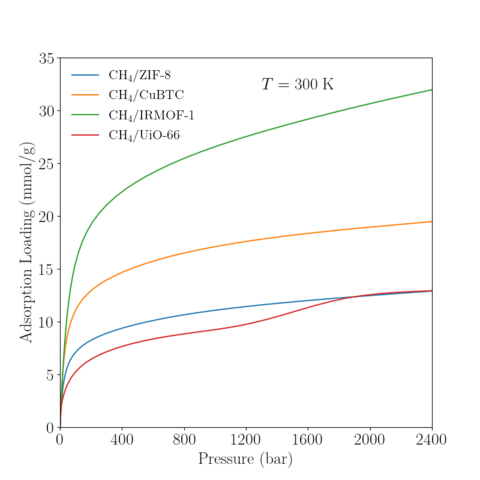
|
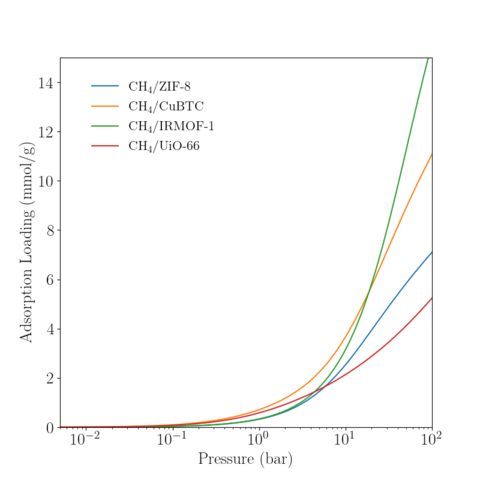
|
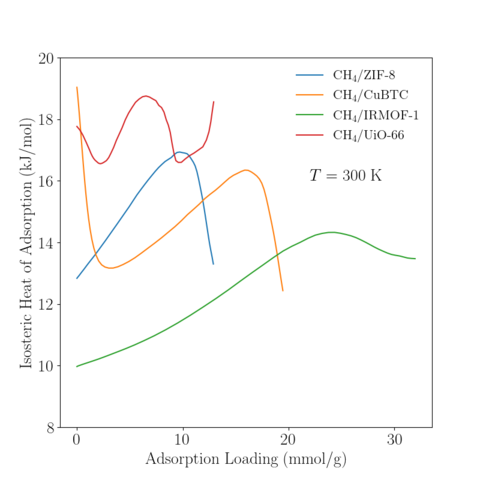
Temperature = 350 K
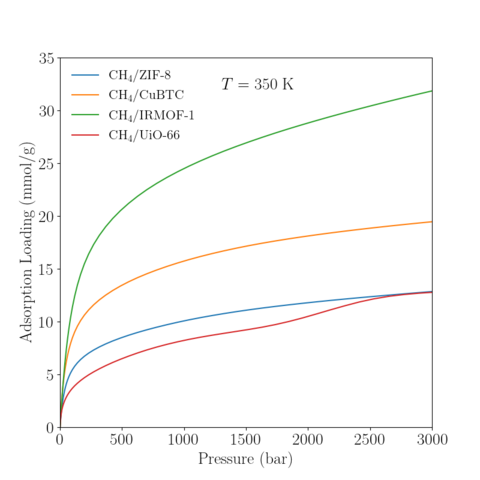
|
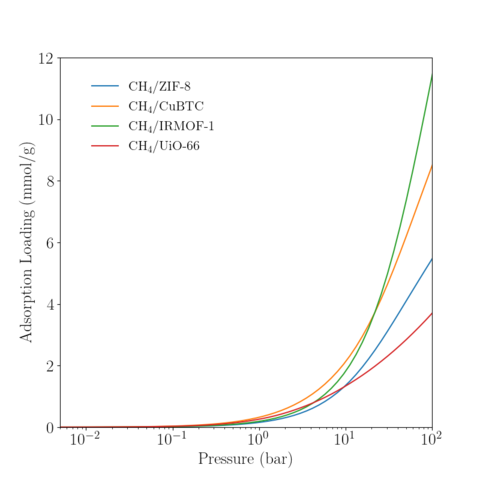
|
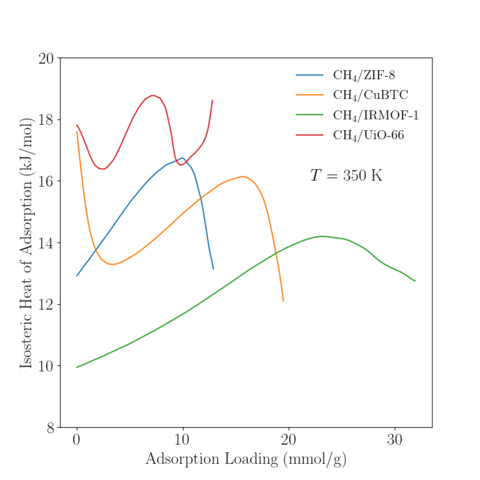
Data Availability
Various data files used to generate the reference isotherms are available in a Git Repository: https://github.com/dwsideriusNIST/NIST_SRSW_Data/tree/master/CH4_REF_ISOTHERMS
Files in the repository include:
FEASST particle files for the MOF materials [includes atomic coordinates and the forcefield parameters]
FEASST particle file for TraPPE CH4
Particle number probability distributions and canonical energy averages for both the bulk and adsorbed CH4
Isotherm data files, including the adsorption isotherm and isosteric heat and estimated uncertainties, formatted as AIF files [20]
References
- J. R. Errington, J. Chem. Phys. 118, 9915 (2003).
- M. P. Allen and D. J. Tildesley, Computer Simulation of Liquids (Oxford University Press, New York, 1989).
- D. Frenkel and B. Smit, Understanding Molecular Simulation, 2nd ed. (Academic, San Diego, 2002)., pp.37-38.
- J. R. Errington and A. Z. Panagiotopoulos, J. Chem. Phys., 109, 1093 (1998).
- J. R. Errington and V. K. Shen, J. Chem. Phys., 123, 164103 (2005).
- V. K. Shen and D. W. Siderius, J. Chem. Phys., 140, 244106, 2014.
- V. K. Shen and J. R. Errington, JPC B 108, 19595, 2004.
- V. K. Shen and J. R. Errington, JCP 122, 064508, 2005.
- V. K. Shen, R. D. Mountain, and J. R. Errington, JPC B 111, 6198, 2007.
- D. W. Siderius and V. K. Shen, JPC C 117, 5681, 2013.
- M. G. Martin and J. I. Siepmann, JPC B 102, 2569 1998.
- CODATA Internationally recommended 2018 values of the Fundamental Physical Constants
- H. W. Hatch, N. A. Mahynski, and V. K. Shen J Res Natl Inst Stan, 123, 123004, 2018.
-
E. I. Todorov and W. Smith, The DL\_POLY User Manual (version 4.03).
-
J. M. Castillo, T. J. H. Vlugt, and S. Calero, JPC C 112, 15934, 2008.
-
P. Ghosh, Y. J. Colón, and R. Q. Snurr, Chem Commun, 50, 11329, 2014.
-
S. L. Mayo, B.D. Olafson and W. A. Goddard, JPC, 26, 8897, 1990.
-
C. Zou, D. R. Penley, E. H. Cho, and L-C. Lin, JPC C 124, 11428, 2020.
-
J. D. Evans, V. Bon, I. Senkovska, S. Kaskel, Langmuir, 37, 4222, 2021.

